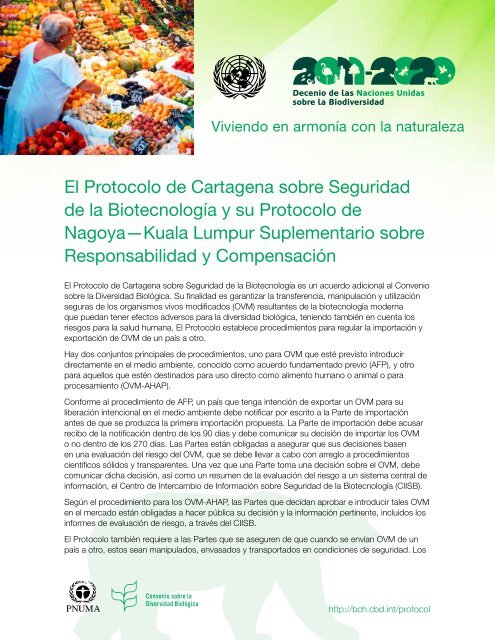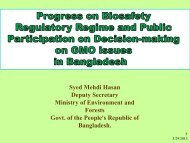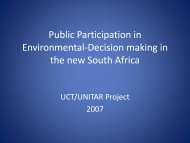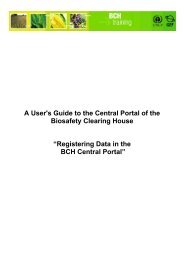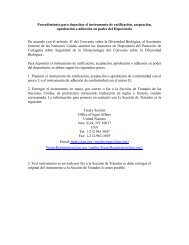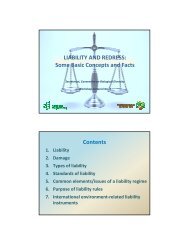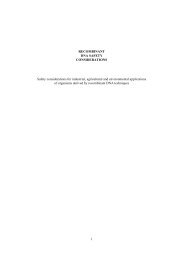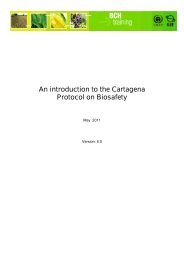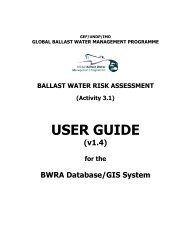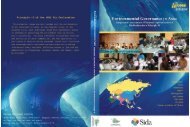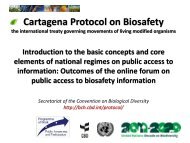El Protocolo de Cartagena sobre Seguridad de la BiotecnologÃa y su ...
El Protocolo de Cartagena sobre Seguridad de la BiotecnologÃa y su ...
El Protocolo de Cartagena sobre Seguridad de la BiotecnologÃa y su ...
Create successful ePaper yourself
Turn your PDF publications into a flip-book with our unique Google optimized e-Paper software.
Viviendo en armonía con <strong>la</strong> naturaleza<br />
<strong>El</strong> <strong>Protocolo</strong> <strong>de</strong> <strong>Cartagena</strong> <strong>sobre</strong> <strong>Seguridad</strong><br />
<strong>de</strong> <strong>la</strong> Biotecnología y <strong>su</strong> <strong>Protocolo</strong> <strong>de</strong><br />
Nagoya—Kua<strong>la</strong> Lumpur Suplementario <strong>sobre</strong><br />
Responsabilidad y Compensación<br />
<strong>El</strong> <strong>Protocolo</strong> <strong>de</strong> <strong>Cartagena</strong> <strong>sobre</strong> <strong>Seguridad</strong> <strong>de</strong> <strong>la</strong> Biotecnología es un acuerdo adicional al Convenio<br />
<strong>sobre</strong> <strong>la</strong> Diversidad Biológica. Su finalidad es garantizar <strong>la</strong> transferencia, manipu<strong>la</strong>ción y utilización<br />
seguras <strong>de</strong> los organismos vivos modificados (OVM) re<strong>su</strong>ltantes <strong>de</strong> <strong>la</strong> biotecnología mo<strong>de</strong>rna<br />
que puedan tener efectos adversos para <strong>la</strong> diversidad biológica, teniendo también en cuenta los<br />
riesgos para <strong>la</strong> salud humana, <strong>El</strong> <strong>Protocolo</strong> establece procedimientos para regu<strong>la</strong>r <strong>la</strong> importación y<br />
exportación <strong>de</strong> OVM <strong>de</strong> un país a otro.<br />
Hay dos conjuntos principales <strong>de</strong> procedimientos, uno para OVM que esté previsto introducir<br />
directamente en el medio ambiente, conocido como acuerdo fundamentado previo (AFP), y otro<br />
para aquellos que estén <strong>de</strong>stinados para uso directo como alimento humano o animal o para<br />
procesamiento (OVM-AHAP).<br />
Conforme al procedimiento <strong>de</strong> AFP, un país que tenga intención <strong>de</strong> exportar un OVM para <strong>su</strong><br />
liberación intencional en el medio ambiente <strong>de</strong>be notificar por escrito a <strong>la</strong> Parte <strong>de</strong> importación<br />
antes <strong>de</strong> que se produzca <strong>la</strong> primera importación propuesta. La Parte <strong>de</strong> importación <strong>de</strong>be acusar<br />
recibo <strong>de</strong> <strong>la</strong> notificación <strong>de</strong>ntro <strong>de</strong> los 90 días y <strong>de</strong>be comunicar <strong>su</strong> <strong>de</strong>cisión <strong>de</strong> importar los OVM<br />
o no <strong>de</strong>ntro <strong>de</strong> los 270 días. Las Partes están obligadas a asegurar que <strong>su</strong>s <strong>de</strong>cisiones basen<br />
en una evaluación <strong>de</strong>l riesgo <strong>de</strong>l OVM, que se <strong>de</strong>be llevar a cabo con arreglo a procedimientos<br />
científicos sólidos y transparentes. Una vez que una Parte toma una <strong>de</strong>cisión <strong>sobre</strong> el OVM, <strong>de</strong>be<br />
comunicar dicha <strong>de</strong>cisión, así como un re<strong>su</strong>men <strong>de</strong> <strong>la</strong> evaluación <strong>de</strong>l riesgo a un sistema central <strong>de</strong><br />
información, el Centro <strong>de</strong> Intercambio <strong>de</strong> Información <strong>sobre</strong> <strong>Seguridad</strong> <strong>de</strong> <strong>la</strong> Biotecnología (CIISB).<br />
Según el procedimiento para los OVM-AHAP, <strong>la</strong>s Partes que <strong>de</strong>cidan aprobar e introducir tales OVM<br />
en el mercado están obligadas a hacer pública <strong>su</strong> <strong>de</strong>cisión y <strong>la</strong> información pertinente, incluidos los<br />
informes <strong>de</strong> evaluación <strong>de</strong> riesgo, a través <strong>de</strong>l CIISB.<br />
<strong>El</strong> <strong>Protocolo</strong> también requiere a <strong>la</strong>s Partes que se aseguren <strong>de</strong> que cuando se envían OVM <strong>de</strong> un<br />
país a otro, estos sean manipu<strong>la</strong>dos, envasados y transportados en condiciones <strong>de</strong> seguridad. Los<br />
http://bch.cbd.int/protocol
envíos <strong>de</strong>ben ir acompañados <strong>de</strong> documentación que i<strong>de</strong>ntifique los OVM con c<strong>la</strong>ridad, especifique los<br />
requisitos para <strong>su</strong> manipu<strong>la</strong>ción, almacenamiento, transporte y uso seguros y proporcione los <strong>de</strong>talles <strong>de</strong><br />
contacto para obtener información adicional.<br />
<strong>El</strong> <strong>Protocolo</strong> <strong>de</strong> Nagoya—Kua<strong>la</strong> Lumpur Suplementario <strong>sobre</strong> Responsabilidad y Compensación refuerza<br />
el <strong>Protocolo</strong> <strong>de</strong> <strong>Cartagena</strong> <strong>sobre</strong> <strong>Seguridad</strong> <strong>de</strong> <strong>la</strong> Biotecnología. <strong>El</strong> <strong>Protocolo</strong> Suplementario especifica <strong>la</strong>s<br />
medidas <strong>de</strong> respuesta que se <strong>de</strong>ben adoptar en el caso <strong>de</strong> daños a <strong>la</strong> diversidad biológica re<strong>su</strong>ltantes <strong>de</strong><br />
los OVM. La autoridad competente <strong>de</strong> una Parte en el <strong>Protocolo</strong> Suplementario <strong>de</strong>be requerir a <strong>la</strong> persona<br />
que tenga el control <strong>de</strong>l OVM (operador) que adopte <strong>la</strong>s medidas <strong>de</strong> respuesta, o pue<strong>de</strong> aplicar dichas<br />
medidas por sí misma y recuperar <strong>de</strong>l operador los costos incurridos.<br />
Datos breves<br />
nn<br />
<strong>El</strong> <strong>Protocolo</strong> <strong>de</strong> <strong>Cartagena</strong> <strong>sobre</strong> <strong>Seguridad</strong> <strong>de</strong> <strong>la</strong><br />
Biotecnología se adoptó el 29 <strong>de</strong> enero <strong>de</strong> 2000<br />
y entró en vigor el 11 <strong>de</strong> septiembre <strong>de</strong> 2003.<br />
Al 11 <strong>de</strong> mayo <strong>de</strong> 2011, 160 países y <strong>la</strong> Unión<br />
Europea habían ratificado el <strong>Protocolo</strong> o se habían<br />
adherido a este.<br />
nn<br />
<strong>El</strong> <strong>Protocolo</strong> <strong>de</strong> Nagoya—Kua<strong>la</strong> Lumpur<br />
Suplementario <strong>sobre</strong> Responsabilidad y<br />
Compensación al <strong>Protocolo</strong> <strong>de</strong> <strong>Cartagena</strong> <strong>sobre</strong><br />
<strong>Seguridad</strong> <strong>de</strong> <strong>la</strong> Biotecnología fue adoptado el 15<br />
<strong>de</strong> octubre <strong>de</strong> 2010 en Nagoya, Japón. Quedó<br />
abierto para firma el 7 <strong>de</strong> marzo <strong>de</strong> 2011.<br />
nn<br />
Por medio <strong>de</strong> <strong>la</strong> biotecnología mo<strong>de</strong>rna,<br />
se modifica el material genético <strong>de</strong> un<br />
organismo con <strong>la</strong> finalidad <strong>de</strong> <strong>de</strong>sarrol<strong>la</strong>r<br />
o mejorar una o más características <strong>de</strong>l<br />
organismo. Si bien esta tecnología tiene<br />
posibilida<strong>de</strong>s <strong>de</strong> aportar beneficios a<br />
<strong>la</strong> humanidad y contribuir al <strong>de</strong>sarrollo<br />
sostenible, se teme que los organismos<br />
vivos modificados re<strong>su</strong>ltantes <strong>de</strong> <strong>la</strong><br />
biotecnología tengan efectos negativos<br />
<strong>sobre</strong> <strong>la</strong> diversidad biológica y <strong>la</strong><br />
salud humana.<br />
Más información<br />
<strong>Protocolo</strong> <strong>de</strong> Nagoya—Kua<strong>la</strong> Lumpur Suplementario <strong>sobre</strong> Responsabilidad<br />
y Compensación al <strong>Protocolo</strong> <strong>de</strong> <strong>Cartagena</strong> <strong>sobre</strong> <strong>Seguridad</strong> <strong>de</strong> <strong>la</strong> Biotecnología<br />
n http://bch.cbd.int/protocol/NKL_Protocol.shtml<br />
Centro <strong>de</strong> Intercambio <strong>de</strong> Información <strong>sobre</strong> <strong>Seguridad</strong> <strong>de</strong> <strong>la</strong> Biotecnología (CIISB)<br />
n http://bch.cbd.int<br />
P<strong>la</strong>n Estratégico para el <strong>Protocolo</strong> <strong>de</strong> <strong>Cartagena</strong> <strong>sobre</strong> <strong>Seguridad</strong> <strong>de</strong> <strong>la</strong> Biotecnología<br />
para el período 2011-2020 n http://bch.cbd.int/protocol/is<strong>su</strong>es/cpb_stp<strong>la</strong>n_txt.shtml<br />
Biosafety Protocol News n http://bch.cbd.int/protocol/cpb_newsletter.shtml<br />
Publicaciones <strong>sobre</strong> el <strong>Protocolo</strong> <strong>de</strong> <strong>Cartagena</strong><br />
n http://bch.cbd.int/protocol/cpb_publications.shtml<br />
Centro <strong>de</strong> Recursos <strong>de</strong> Información <strong>sobre</strong> <strong>Seguridad</strong> <strong>de</strong> <strong>la</strong> Biotecnología<br />
n http://bch.cbd.int/database/resources<br />
Secretaría <strong>de</strong>l Convenio <strong>sobre</strong> <strong>la</strong> Diversidad Biológica<br />
413, Saint Jacques Street, Suite 800<br />
Montreal Quebec H2Y 1N9<br />
Canada<br />
Tel: +1 514 288 2220<br />
Fax: +1 514 288 6588<br />
UNBiodiversity@cbd.int<br />
http://bch.cbd.int/protocol


